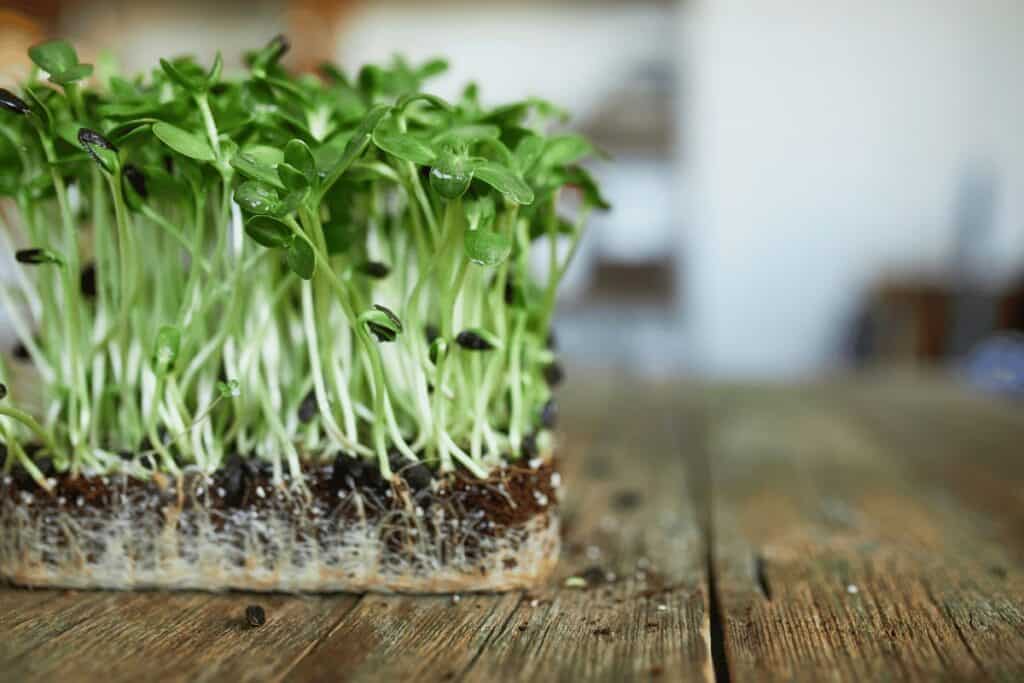Microgreens have gained popularity among home gardeners due to their versatility and nutritional benefits. However, it can be disheartening when your microgreens fail to thrive despite your best efforts. In the article, Why Are My Microgreens Not Growing? we will explore the common problems faced by microgreen growers and provide effective solutions to help you overcome these challenges.
Introduction
Microgreens have become a go-to choice for many gardening enthusiasts, as they offer a quick and convenient way to grow nutrient-rich greens at home. However, growing microgreens successfully requires proper knowledge and troubleshooting skills. In this article why Are My Microgreens Not Growing?, we will address the most common problems encountered by microgreen growers and guide you toward finding solutions.
Why Are My Microgreens Not Growing?

Mold or Fungus
Mold or fungus growth is a common issue faced by microgreen growers. It can hinder the growth and development of your microgreens if not addressed promptly. Differentiating between root hairs and mold is crucial. Root hairs are light and typically surround the root area, while mold appears darker and covers the soil or surrounding seeds.
Causes of Mould
Mold thrives in specific conditions, including high humidity, lack of circulation, and unclean trays or pots. To prevent mold formation, it is essential to ensure cleanliness and proper ventilation.
Remedies for Mould
To prevent mold formation, start by thoroughly washing and cleaning the tray used for germinating seeds. Good ventilation plays a vital role in preventing high humidity, although it might be challenging during the blackout period. Avoid over-seeding the tray and remove any section infected with mold. If the entire tray is infected, it is advisable to discard it and start over with a new tray [1].
Slow Germination
If your microgreens are taking longer than expected to germinate, it can be frustrating. Understanding the reasons behind slow germination can help you take appropriate action.
Factors Affecting Germination
Typically, germination for most microgreen seeds should occur within 2-4 days. If it is taking longer, inadequate moisture levels might be the cause. Check the seeds and potting mix in your tray during the blackout period. If they appear too dry, gently spray them with water to increase moisture levels.
Uneven Growth
Uneven growth in microgreens can be attributed to various factors. Ensuring the even distribution of seeds during sowing is essential, especially when dealing with tiny seeds like amaranth, basil, and broccoli. Using a seed feeder, such as a herb bottle with a dispensing cap, can help control the spread and promote even growth.
Seed Quality and Germination
The quality of the seeds you use plays a significant role in the success of your microgreen cultivation. Poor seed quality can lead to suboptimal germination rates and hinder the growth of your microgreens.
Identifying Seed Quality Issues
Seeds that are too old or not stored under ideal conditions can degrade over time. It is essential to source seeds from reputable suppliers who provide fresh, well-tested seeds with high germination rates and low pathogen presence.
Common Microgreen Problems and Solutions
Microgreens can face various issues throughout their growth cycle. Understanding these problems and their solutions will empower you to grow healthy microgreens consistently. Here are some common problems you may encounter:
Problem 1: Growing Mold
Mold growth on microgreens can occur due to excess humidity and inadequate light. It is crucial to maintain the right temperature and humidity levels for optimal growth. Removing visible mold with a soft cloth and ensuring proper airflow can help manage this issue [3].
Problem 2: Slow Germination
Slow germination can result from factors such as insufficient moisture, poor seed quality, or improper temperature. Adjusting moisture levels, using high-quality seeds, and providing appropriate temperature conditions can help accelerate germination [2].
Problem 3: Uneven Growth
Uneven growth in microgreens can occur due to overcrowding during sowing or inconsistent moisture levels. Spreading seeds evenly and ensuring adequate moisture throughout the growing process can promote more uniform growth.
Problem 4: Yellowing Microgreens
Yellowing microgreens can indicate nutrient deficiencies, excessive watering, or poor air circulation. Adjusting watering practices, ensuring proper ventilation, and providing adequate nutrients can help prevent yellowing.
Problem 5: Wilting Microgreens
Wilting microgreens are often a result of insufficient moisture or excessive heat. Proper watering and maintaining appropriate temperature conditions are crucial to prevent wilting.
Problem 6: Foul Odor
Foul odors emanating from your microgreens could indicate bacterial or fungal growth. Maintaining cleanliness, proper airflow, and avoiding overwatering can help mitigate this issue.
Problem 7: Clumping
Clumping of microgreens occurs when seeds are sown too densely. Using a seed feeder or distributing seeds more evenly during sowing can prevent clumping.
Problem 8: Pest Infestation
Microgreens can be vulnerable to pest infestations. Implementing preventive measures such as maintaining cleanliness, inspecting for pests regularly, and using organic pest control methods can help keep pests at bay.
Conclusion Why Are My Microgreens Not Growing?
Growing microgreens can be a rewarding experience, but it is not without challenges. By understanding and addressing common problems like mold growth, slow germination, uneven growth, yellowing, wilting, foul odor, clumping, and pest infestation, you can overcome obstacles and cultivate healthy microgreens successfully.
Incorporating proper moisture management, high-quality seeds, adequate spacing, and appropriate environmental conditions will set the foundation for successful microgreen cultivation. So don’t be disheartened if your microgreens are not growing as expected. With patience, experimentation, and the right knowledge, you can enjoy the benefits of homegrown microgreens.
FAQs
1. How can I prevent mold growth on my microgreens?
To prevent mold growth, ensure proper ventilation, maintain cleanliness, and avoid overwatering. If you encounter mold, remove it immediately and take steps to improve airflow and reduce humidity [1].
2. Why are my microgreens taking longer to germinate?
Slow germination can be due to insufficient moisture, poor seed quality, or inappropriate temperature conditions. Ensure adequate moisture levels, use high-quality seeds, and maintain the recommended temperature range for optimal germination [2].
3. How can I promote even growth in my microgreens?
To promote even growth, avoid overcrowding during sowing and ensure consistent moisture levels throughout the growing process. Spreading seeds evenly and providing proper airflow can also contribute to more uniform growth.
4. What causes yellowing in microgreens?
Yellowing microgreens can result from nutrient deficiencies, overwatering, or inadequate air circulation. Adjust watering practices, provide adequate ventilation, and ensure proper nutrient availability to prevent yellowing.
5. How do I prevent pest infestations in my microgreens?
To prevent pest infestations, maintain cleanliness, regularly inspect your plants for pests, and consider using organic pest control methods. These measures can help keep pests at bay and protect your microgreens.




